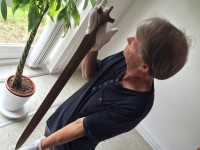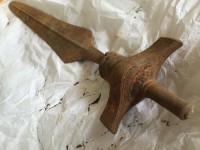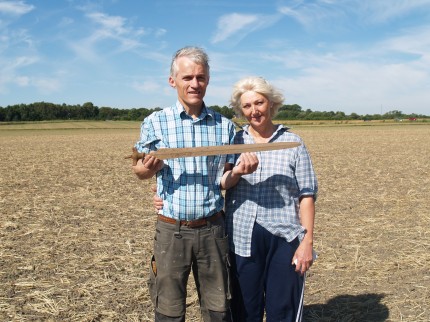 Ernst Christiansen and Lise Therkelsen were enjoying a leisurely evening constitutional in a field in Forsinge, western Zealand, when their metal detector signalled the presence of something underground. They dug less than a foot underground and found the tip of what looked a lot like a sword. As experienced and responsible metal detectorists, they recognized the object could be archaeologically significant, so they reburied it and the next morning alerted the Museum Vestsjælland (Museum of West Zealand) to the find.
Ernst Christiansen and Lise Therkelsen were enjoying a leisurely evening constitutional in a field in Forsinge, western Zealand, when their metal detector signalled the presence of something underground. They dug less than a foot underground and found the tip of what looked a lot like a sword. As experienced and responsible metal detectorists, they recognized the object could be archaeologically significant, so they reburied it and the next morning alerted the Museum Vestsjælland (Museum of West Zealand) to the find.
Curator of the museum’s archaeology department Arne Hedegaard Andersen, with the aid of the finders, excavated the artifact. It’s a sword 82 centimeters (2’8″) long; the blade alone is 67 centimeters (26 inches) long. The sword is astonishingly well preserved: intact from tip to hilt (although the grip, which was likely made of an organic material like wood or horn, is gone) with fine decorations still visible. The edge is even still sharp. Museum experts date it to Phase IV of the Nordic Bronze Age, between 1100 and 900 B.C., so it has kept a keen edge for 3,000 years.
 The sword is of a type known in Danish as a hornknapsværd, which translated to a horn button sword. (I wasn’t able to find any English scholarship on the sword type using that translation, so either it has another name in English or it’s enough of a niche area not to have much of a web presence. If anyone knows of an English name for this type sword, please let me know in the comments.) The blade is long and narrow with slightly sloping shoulders leading into the hilt. The grip has a short pair of arms and ends with a long narrow tip. Including that tip, the grip is 10 cm (4 inches) long. The arms are around nine cm wide. The grip is decorated with recessed lines and arches.
The sword is of a type known in Danish as a hornknapsværd, which translated to a horn button sword. (I wasn’t able to find any English scholarship on the sword type using that translation, so either it has another name in English or it’s enough of a niche area not to have much of a web presence. If anyone knows of an English name for this type sword, please let me know in the comments.) The blade is long and narrow with slightly sloping shoulders leading into the hilt. The grip has a short pair of arms and ends with a long narrow tip. Including that tip, the grip is 10 cm (4 inches) long. The arms are around nine cm wide. The grip is decorated with recessed lines and arches.
The sword will be on public display very briefly on September 7th from 1:00-4:00 PM at the Kalundborg Museum. Finders Ernst Christiansen and Lise Therkildsen and curator/excavator Arne Hedegaard Andersen will be at the special presentation to talk about the sword and answer questions from the visitors. After that quick viewing, the artifact will be processed and catalogued.

The hornknapsværd might refer to swordknob or pommel (ger.: ‘Knauf’). The chap holding the sword in the first pic, seems to be Arne instead of Ernst Christiansen.
“From Middle English knobbe, from Middle Low German knobbe, knoppe (“a knot in wood”), from Proto-Germanic *knuppô (“lump, clod”), from Proto-Indo-European *gneub-, *gneup- (“to press, crush”), cf. *gnebʰ-. Cognate with Dutch knop (“button, knob”), German Knopf (“button, knob”), Swedish knopp (“knob”), Old English cnoppa (“knob”). See also knop”
Compare it to this -slightly younger- sword from around 500BC, seemingly sporting a [possible, I even dare say ‘horny’] so-called ‘Knollenknauf‘.
Missing, however, on the specimen from Denmark seem two “reversed Y-shaped parts”, which could have been connected in order to form a proper ‘hilt’ and also the blade-sided ‘knollens’.
Who lived in Denmark 3000 years ago? Predominantly the ancestors of the present Danes?
Okay, I hate to admit it, but I actually gasped a little when I saw this thing.
The condition it’s in after 3,000 years is unbelievable!
I was really struck by the amazing preservation as well. Any idea how rare it is to find Bronze Age tools/artifacts in such good shape?